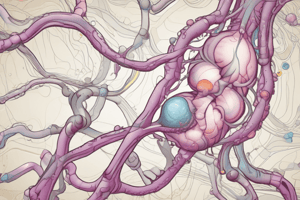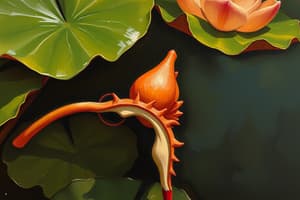Podcast
Questions and Answers
How do ADH and aldosterone differ in their mechanisms of action within the kidneys?
How do ADH and aldosterone differ in their mechanisms of action within the kidneys?
- ADH and aldosterone both act on the proximal convoluted tubule, but aldosterone acts faster.
- ADH increases water reabsorption by absorbing sodium chloride, while aldosterone causes water reabsorption through aquaporins.
- ADH increases water reabsorption by stimulating the production of aquaporins, while aldosterone promotes sodium and chloride reabsorption, leading to water reabsorption. (correct)
- ADH causes reabsorption of sodium chloride, while aldosterone increases water reabsorption through aquaporins.
What is the primary function of the proximal convoluted tubule (PCT) in the nephron?
What is the primary function of the proximal convoluted tubule (PCT) in the nephron?
- Bulk reabsorption of nutrients, electrolytes, and water back into the bloodstream. (correct)
- Concentration of urine by reabsorbing water in response to ADH.
- Fine-tuning water and salt reabsorption under hormonal control.
- Secretion of waste products and excess substances into the filtrate.
How does the structure of the glomerulus, specifically the difference in diameter between the afferent and efferent arterioles, contribute to its function?
How does the structure of the glomerulus, specifically the difference in diameter between the afferent and efferent arterioles, contribute to its function?
- The larger diameter of the efferent arteriole reduces pressure, aiding in reabsorption.
- The smaller diameter of the efferent arteriole increases pressure within the glomerulus, promoting filtration. (correct)
- The smaller diameter of the afferent arteriole increases blood pressure, slowing filtration rate.
- The equal diameters maintain constant blood flow for consistent filtration.
Which of the following accurately describes the layers of the filtration barrier in the glomerulus and their respective functions?
Which of the following accurately describes the layers of the filtration barrier in the glomerulus and their respective functions?
What is the primary difference in function between the kidney cortex and the kidney medulla?
What is the primary difference in function between the kidney cortex and the kidney medulla?
A patient's urinalysis reveals a high glucose level (glycosuria). Which of the following best explains the underlying mechanism for this finding?
A patient's urinalysis reveals a high glucose level (glycosuria). Which of the following best explains the underlying mechanism for this finding?
How does Atrial Natriuretic Peptide (ANP) work to reduce blood pressure and fluid volume?
How does Atrial Natriuretic Peptide (ANP) work to reduce blood pressure and fluid volume?
During periods of dehydration, what changes occur in ADH secretion and urine production to help the body conserve water?
During periods of dehydration, what changes occur in ADH secretion and urine production to help the body conserve water?
What is the primary function of renin in the renin-angiotensin-aldosterone system (RAAS)?
What is the primary function of renin in the renin-angiotensin-aldosterone system (RAAS)?
In a person experiencing alkalosis, how do the kidneys respond to restore blood pH balance?
In a person experiencing alkalosis, how do the kidneys respond to restore blood pH balance?
Which of the following describes the effect of a longer loop of Henle on urine concentration?
Which of the following describes the effect of a longer loop of Henle on urine concentration?
Under what conditions would the kidneys release erythropoietin (EPO)?
Under what conditions would the kidneys release erythropoietin (EPO)?
What is the glomerular filtration rate (GFR)?
What is the glomerular filtration rate (GFR)?
What triggers the release of renin by the kidneys?
What triggers the release of renin by the kidneys?
Which part of the nephron is primarily responsible for the reabsorption of glucose back into the bloodstream?
Which part of the nephron is primarily responsible for the reabsorption of glucose back into the bloodstream?
What is the effect of aldosterone on sodium and water balance in the kidneys?
What is the effect of aldosterone on sodium and water balance in the kidneys?
What is the primary purpose of secretion in the nephron?
What is the primary purpose of secretion in the nephron?
Where does filtration exclusively occur in the kidneys?
Where does filtration exclusively occur in the kidneys?
If a person is sweating a lot and losing water, what happens to their ADH levels, and why?
If a person is sweating a lot and losing water, what happens to their ADH levels, and why?
What is the role of juxtaglomerular cells?
What is the role of juxtaglomerular cells?
Flashcards
ADH & Aldosterone
ADH & Aldosterone
Antidiuretic hormones that work in the distal tubule.
ADH (Antidiuretic Hormone)
ADH (Antidiuretic Hormone)
Released by the pituitary gland, increases water reabsorption in the distal tubule by increasing aquaporins.
Aldosterone
Aldosterone
Secreted by the adrenal gland, it increases sodium chloride reabsorption in the distal tubule, followed by water.
Proximal Convoluted Tubule (PCT)
Proximal Convoluted Tubule (PCT)
Signup and view all the flashcards
Glomerulus
Glomerulus
Signup and view all the flashcards
Afferent Arteriole
Afferent Arteriole
Signup and view all the flashcards
Efferent Arteriole
Efferent Arteriole
Signup and view all the flashcards
Filtration Barrier
Filtration Barrier
Signup and view all the flashcards
Glomerular Filtrate
Glomerular Filtrate
Signup and view all the flashcards
Kidney Cortex
Kidney Cortex
Signup and view all the flashcards
Kidney Medulla
Kidney Medulla
Signup and view all the flashcards
Renin
Renin
Signup and view all the flashcards
Angiotensin II
Angiotensin II
Signup and view all the flashcards
Aldosterone
Aldosterone
Signup and view all the flashcards
Reabsorption
Reabsorption
Signup and view all the flashcards
Secretion
Secretion
Signup and view all the flashcards
Collecting Duct
Collecting Duct
Signup and view all the flashcards
Filtration
Filtration
Signup and view all the flashcards
Atrial Natriuretic Peptide (ANP)
Atrial Natriuretic Peptide (ANP)
Signup and view all the flashcards
Erythropoietin (EPO)
Erythropoietin (EPO)
Signup and view all the flashcards
Study Notes
- ADH and aldosterone are both antidiuretic hormones functioning in the distal tubule.
- ADH is released by the pituitary gland.
- Aldosterone is released by the adrenal gland.
- ADH increases water reabsorption by binding to receptors, prompting cells to produce aquaporins.
- Aquaporins are water protein channels that facilitate water reabsorption; it's a long-term regulation method.
- Aldosterone promotes sodium chloride reabsorption, followed by water.
- Aldosterone helps retain salt and water, increasing blood volume and maintaining blood pressure.
- ADH helps retain water, decreasing urine output and maintaining hydration.
- Aldosterone regulates sodium and water retention to control blood pressure and volume.
- ADH controls water retention, preventing excessive water loss and maintaining hydration.
- ADH causes water reabsorption by means of aquaporins.
- Aldosterone leads to water reabsorption by absorbing sodium chloride, and then water follows.
- The proximal convoluted tubule (PCT) is where the most reabsorption occurs in the kidneys.
- The PCT is the primary site for bulk reabsorption, especially of nutrients and electrolytes.
- The proximal convoluted tubule uses active transport (ATP) to pick up sodium chloride.
- Active diffusion is involved in sodium chloride transport in the PCT.
The Glomerulus
- The glomerulus is a capillary network inside the renal corpuscle.
- Its function is to filter blood and remove waste and excess fluids.
Main Parts of the Glomerulus
- The afferent arteriole brings blood into the glomerulus.
- The efferent arteriole carries blood away from the glomerulus after it has been filtered.
- The efferent arteriole has a smaller diameter than the afferent arteriole to increase pressure, which helps filtration.
- The capillary network within the glomerulus has small pores that allow water, salts, glucose, and waste products to pass through.
Filtration Barrier
- The blood in the glomerulus is filtered through a filtration barrier with three layers.
- Endothelial cells have pores that allow small substances to pass but block larger molecules.
- The basement membrane prevents large proteins from passing into the filtrate.
- Podocytes have pedicels that form tiny slits to filter out large particles as a "last line of defense".
- Glomerular filtrate contains water, electrolytes, glucose, amino acids, and waste products, but little protein or red blood cells.
Key functions of the glomerulus:
- Blood enters the glomerulus through the afferent arteriole.
- The glomerulus filters small molecules while blocking larger ones.
- Filtered liquid (filtrate) exits through the efferent arteriole.
- The filtration process is pressure-driven and selective.
Kidney Cortex (Outer Part):
- The cortex is the outer layer of the kidney and the site of blood filtration.
- It contains nephrons (filtering units) that clean the blood and recover useful substances.
Kidney Medulla (Inner Part):
- The medulla is the inner part of the kidney, underneath the cortex.
- The medulla concentrates urine by extracting water to ensure water retention in the body.
Key difference between kidney structures:
- The cortex filters blood in the initial stage of urine creation.
- The medulla concentrates urine and helps conserve water.
- Cortex is for blood filtering.
- Medulla is for urine concentrating.
Additional kidney facts
- The medulla is hypertonic to the cortex.
- Renin is secreted by juxtaglomerular cells in the juxtaglomerular apparatus, near the glomerulus.
- Juxtaglomerular cells monitor blood pressure and sodium concentration.
- If blood pressure/sodium levels are low, juxtaglomerular cells release renin into the bloodstream.
- Renin is an enzyme that triggers the renin-angiotensin-aldosterone system (RAAS) to increase blood pressure.
- Renin converts angiotensinogen to angiotensin I, which converts to angiotensin II, which starts ADH and aldosterone secretion.
- Afferent vessels bring blood into kidneys; efferent vessels bring blood out of the kidneys.
Filtration
- Is the cleaning of blood; the kidneys filter out waste, extra water, and unneeded substances.
- It occurs in the glomerulus (renal corpuscle).
- Blood enters the kidney through the afferent arteriole and is pushed into the glomerulus, which is a ball of capillaries.
- Blood pressure forces water, waste, and small molecules into the Bowman's capsule.
- Larger molecules remain in the blood.
Reabsorption
- Is when the kidneys retrieve the useful substances (water, glucose, salts) from the filtrate and return them to the blood.
- Occurs in the proximal convoluted tubule (PCT), loop of Henle, and distal convoluted tubule (DCT).
- PCT - most substances are reabsorbed in this first section.
- Loop of Henle - helps reabsorb water and sodium.
- DCT - fine-tunes water and salt reabsorption with hormones like aldosterone and ADH.
Secretion
- Kidneys add more waste and extra substances (drugs, hydrogen ions) into the filtrate to be removed from the body in urine.
- The DCT and collecting duct is where it occurs.
- DCT - such substances are secreted into the filtrate.
- The collecting duct also helps adjust the secretion of waste products and regulates water balance under ADH influence.
Summary of Kidney Functions:
- Filtration occurs in the glomerulus, where blood is cleaned and waste separates.
- Reabsorption occurs mostly in the PCT, Loop of Henle, and DCT, where useful substances (water, salts, glucose) are reabsorbed back into the blood.
- Secretion occurs in the DCT and collecting duct, where extra waste and substances are added to the filtrate for excretion in urine.
- Filtration = cleaning blood
- Reabsorption = taking back useful stuff
- Secretion = getting rid of extra waste
Flow of Urine
- Nephrons → Renal Pyramids → Minor Calyces → Major Calyces → Renal Pelvis → Ureter→ Bladder → Urethra → Out of the body!
Blood flow to the Kidneys:
- Kidneys receive about 20% of the heart's output.
Acid-base balance in the kidneys
- The kidneys regulate acid (H+) and base concentrations.
- Kidneys excrete hydrogen ions to remove excess acid.
- Kidneys reabsorb bicarbonate.
Pressures of the Glomerulus
- Hydrostatic pressure, osmotic pressure, and oncotic pressure are at play in the glomerulus.
- Hydrostatic pressure is higher than the other pressures, facilitating filtration.
- ANP is a diuretic.
- ANP lowers blood pressure by widening blood vessels, increasing sodium and water excretion, and blocking aldosterone.
- ANP helps the body eliminate excess fluid and lower blood pressure when needed.
- Peritubular capillaries retrieve useful substances and help remove waste.
Key functions of blood vessels in kidney filtration
- Reabsorption: Taking back useful substances into the blood.
- Secretion: Adding waste products to the urine.
- Peritubular capillaries help trap sodium chloride.
Abnormal urine findings:
- Glucose in urine (glycosuria) can indicate diabetes.
- Significant protein in urine may indicate high protein intake or renal disease.
Normal urine:
- Has plasma and little to no protein.
Re-absorption Rates:.
- 90% of plasma is re-absorbed
- 90% of chloride is re-absorbed.
- Erythropoietin (EPO) is released by the kidneys when oxygen levels are low.
- EPO helps the bone marrow make more red blood cells, increasing the oxygen-carrying capacity of the blood.
Additional kidney Structure review
- Cortex: Outer layer where blood filtration occurs.
- Medulla: Inner area that concentrates urine.
- Renal Pelvis: Central space where urine collects before being sent to the ureter.
- The cortex is the filtering area, the medulla concentrates the urine, and the renal pelvis is the collection point.
- Three molecules are secreted by the adrenal gland
- Adrenaline (Epinephrine): Increases heart rate, prepares the body for stress ("fight or flight").
- Aldosterone: Regulates sodium and water balance to control blood pressure.
- Cortisol: Helps manage stress, increases blood sugar, and reduces inflammation.
- A zymogen is an inactive enzyme that activates upon a change.
ADH and dehydration
- Sweating a lot causes the production of ADH, leading to reabsorption of water to maintain blood pressure.
- Drinking a lot of water reduces ADH produced.
- The body uses ADH to balance how much water you keep in your system to stay properly hydrated.
GFR and tubular flow.
- If GFR/tubular flow is low, renin is secreted, which causes antogensisn to become antogensisn1& 2.
- GFR measures the amount of blood filtered by the glomerulus each minute, and tubular flow refers to the flow of fluid through the tubules.
- If GFR is low it means the kidneys aren't filtering enough blood, which may mean bad waste and fluid balance.
- The kidneys respond to low GFR by releasing renin, that regulates blood pressure and fluid balance.
- Renin is released by the kidneys when they sense that GFR is low.
- Renin triggers the conversion of a substance call angiotensinogen into angiotensin I
- Angiotensin I is then converted to angiotensin II which stimulates the adrenal glands to release aldosterone.
- Aldosterone helps the kidneys retain sodium and water, which increases blood volume and blood pressure.
- ADH (Antidiuretic Hormone) may also be released to reabsorb water.
- In acidosis, the kidneys get rid of H+ ions to raise pH.
- In alkalosis, the kidneys get rid of bicarbonate to lower pH.
- Glucose is reabsorbed in the kidneys mainly in the proximal convoluted tubule (PCT)
Overload
- When more glucose is present in the blood than the kidneys can handle, as in diabetes, glucose appears in the urine.
- The kidneys have carrier molecules to help reabsorb glucose.
- If there's too much glucose in the blood the carrier molecules can't keep up and are overwhelmed
- As a result, the extra glucose stays in the kidneys' tubules and ends up in the urine.
- The Loop of Henle helps the kidneys concentrate urine, so the body can retain water and not lose too much in urine. •The longer the Loop of Henle, the more water the animal can reabsorb from the urine, making it more concentrated. •The shorter the Loop of Henle, the less water the animal can reabsorb, and the urine becomes more diluted.
- Sharks live in saltwater environments, so they Sharks have a shorter Loop of Henle.
- Desert rats live in dry environments, so they have a longer Loop of Henle.
- Sharks have a shorter Loop of Henle because they live in saltwater and need to get rid of excess salt, not conserve water.
- Desert rats have a longer Loop of Henle because they live in dry environments and need to concentrate their urine to save water and prevent dehydration.
Studying That Suits You
Use AI to generate personalized quizzes and flashcards to suit your learning preferences.




